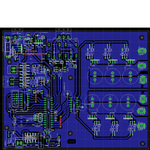Mhd_majar
Newbie level 3
Hello everybody.
This is my first post here, very glad to put an effort with you.
I'm working on a Push-Pull SineWave inverter using Atmega8 and IR2110 mosfet driver driving 55v-110A IRF3205 mosfets in push-pull topology.
when I connected the battery one side blown while the other continued working well. so I replaced the destroyed mos and double checked the circuit to avoid mis-connecting any part.
after that I used 1-ohm current limiter in series with the battery (to avoid any mis-connection bad resaults.) but I noticed that there is a huge NO-load current drained from the batteries causing the resistor to crash :-?
I thought that the current is due to the saturation of the IRON core of my transformer so I used 2 * 4400uF-63v capacitor as a filter (connected each one between the center tap and the end of transformer respecting polarity ) but nothing helped. :-(
when I tried to load a 100-watt lamp the mosfet blown again -_-
I reviewed what Mr.Tahmid talked about (adding resistor between G and S and I added 6.8k ohm resistor and gate protection Zener -15v but also failed again )
I'm driving the mosfets in 15kHz with 312 pulse per 20ms.



This is my first post here, very glad to put an effort with you.
I'm working on a Push-Pull SineWave inverter using Atmega8 and IR2110 mosfet driver driving 55v-110A IRF3205 mosfets in push-pull topology.
when I connected the battery one side blown while the other continued working well. so I replaced the destroyed mos and double checked the circuit to avoid mis-connecting any part.
after that I used 1-ohm current limiter in series with the battery (to avoid any mis-connection bad resaults.) but I noticed that there is a huge NO-load current drained from the batteries causing the resistor to crash :-?
I thought that the current is due to the saturation of the IRON core of my transformer so I used 2 * 4400uF-63v capacitor as a filter (connected each one between the center tap and the end of transformer respecting polarity ) but nothing helped. :-(
when I tried to load a 100-watt lamp the mosfet blown again -_-
I reviewed what Mr.Tahmid talked about (adding resistor between G and S and I added 6.8k ohm resistor and gate protection Zener -15v but also failed again )
I'm driving the mosfets in 15kHz with 312 pulse per 20ms.




